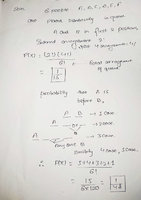How many ways can you order k distinct things without replacement!
This is one of the combinatoric formulas, you should memorize.
[MATH]k![/MATH]
If you have one item, you can order it in only one way. or 1!.
With two items, you can order it CD or DC, two ways or 2!.
With three items, you can order them CDE, CED, DCE, DEC, ECD, or EDC, six ways or 3!.
With four items, you can order them CDEF. CDFE, CEDF, CEFD, CFDE, CFED, DCEF, DCFE, DECF, DEFC, DFCE, DFEC, ECDE, ECED, EDCF, EDFC, EFCD, EFDC, FCDE, FCED, FDCE, FDEC, FECD, or FEDC, 24 ways or 4!.
How many distinct ways can A and B occupy the first two spots: 2!.
So the number of distinct ways that A and B can occupy the first two spots is 2! = 2. The number of ways that that C, D, E, and F can occupy the last four spots is 4! The number of distinct ways that the six can occupy all six spots? 6!
So the probability that A and B are in the first two spots is
[MATH]\dfrac{2! * 4!}{6!} = \dfrac{2 * 4!}{6 * 5 * 4!} = \dfrac{1}{15}.[/MATH]
We can get that answer a different way.
What is the probability of getting A in the first spot and B in the second spot?
[MATH]\dfrac{1}{6} * \dfrac{1}{5} = \dfrac{1}{30}.[/MATH]
Where did that come from?
What is the probability of getting B in the first spot and A in the second spot.
[MATH]\dfrac{1}{6} * \dfrac{1}{5} = \dfrac{1}{30}.[/MATH]
But A first and B second and B first and A second are mutually exclusive so the probability of one or the other is simply the sum of
the two probabilities.
[MATH]\dfrac{1}{15} + \dfrac{1}{15} = \dfrac{2}{30} = \dfrac{1}{15}.[/MATH]
There are usually several ways to attack such problems. Try to think of two simple ones and see if the answers agree. If they do agree, you are very likely correct.



